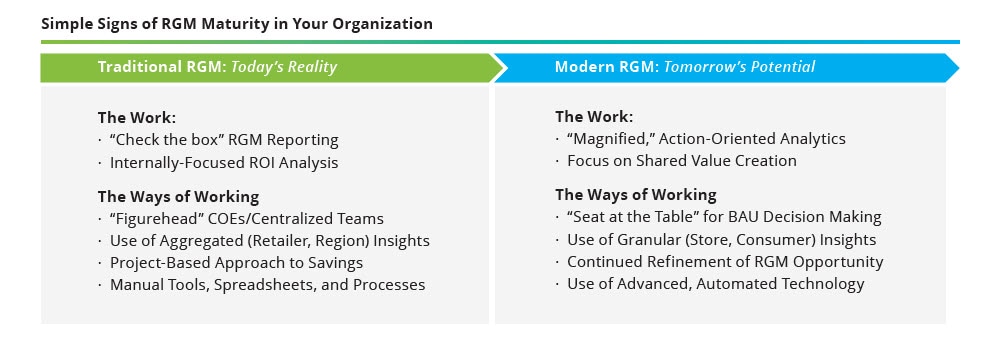Optimizing revenue growth management in the CPG industry has been saved

Perspectives
Optimizing revenue growth management in the CPG industry
How analytics can uncover new growth opportunities
Disruptive forces are creating opportunities for consumer-packaged goods (CPG) companies to modernize revenue growth management (RGM) by magnifying complex, action-oriented analytics. To gain industry advantage, we believe such actions can generate benefits equal to three to five percent of gross profit while creating value for retailers and consumers.
Explore content
- Revenue growth management for consumer products companies
- Driving organizational maturity in RGM
- A modern approach to revenue growth management
- Uncovering “hidden” value today
- Investing in sustained success
The current state of revenue growth management
Today’s CPG companies operate in a dynamic marketplace with investors demanding a balance between maintaining top-line revenue growth and managing sustainable profit margins. Revenue growth remains challenging as the widening income gap creates consumer micro-markets with unique strategic needs.
Consumers are increasingly evaluating new brands, purchasing channels, and service models as they fulfill their needs in ways that add convenience to their lives and allow them to tailor purchases to unique needs.
The rise of "mass-to-micro" has resulted in the emergence of smaller, nimble competitors that are better able to win market share and consumer loyalty through more localized settings and the ability to offer more personalized offerings.
CPG companies are looking for new ways to find the appropriate balance between growth and efficiency. Based on our experience, the most immediate and impactful means of improving growth while protecting margins is through the approach known as revenue growth management (RGM). RGM, which focuses on pricing, promotions, product assortment, brand-pack price architecture, and the management of the gross-to-net spend isn’t necessarily a new concept among most CPG companies. However, many CPG companies continue to use basic, rudimentary methods, including limited internal data to find value across price-volume mix, trade spend, and promotion. This is shocking, considering trade spending often accounts for 20 to 30 percent of gross sales and is typically the second largest area in the P&L behind the cost of goods sold.
Driving organizational maturity in RGM
The environment described above requires a new approach to the revenue/margin balance equation. We believe revenue growth management is a key component of this equation, but it often requires a shift away from traditional models. In our experience, there are several tell-tale signs of an organizational RGM maturity:

A modern approach to revenue growth management
While RGM may never be an easy practice, we believe emerging technology, artificial intelligence, and tools can help accelerate the shift toward a more modern approach. While it would require additional investment (though it need not be significant), we believe CPG companies, seeking an industry advantage, can follow a two-step approach to facilitate the shift from traditional to modern:
Step one: Uncover hidden value, based on rigorous—and often overlooked—areas of analysis.
We believe these analyses can not only drive financial results, but they can also force organizations to think differently and enhance RGM capabilities. This ability to generate top- and bottom-line results can help build organizational momentum and create a self-funding business case for step two.
Step two: Make data and technology investments to build sustainable, always-on capabilities.
The CPG industry is unlikely to become less dynamic or less challenging and, as such, a RGM microscope will be in constant use. Organizations need new solutions and capabilities to drive continued market success.
Uncovering “hidden” value today
Our recent experience suggests that many CPG companies still have scope to generate significant top-line growth and margin optimization by focusing on strategic areas of RGM. We believe the right set of analytics that engage price and promotional levers can generate benefits equal to three to five percent of gross profit per year. In addition to these financial benefits, we believe these four opportunities can help build organizational capabilities and increase understanding of growth dynamics in the market:
Shoppers are becoming more empowered every day, and many expect personalized, shopper-centric environments when making purchase decisions. Furthermore, digital access and market transparency provide consumers with greater visibility to product assortment, inventory availability, and price differences, both within their local market geography and across physical and digital storefronts.
These shifts have implications for CPG companies’ approaches to revenue growth management. As shopper behavior changes, the composition of the wallet shifts between retailers, and retail shelf-space becomes more competitive, CPG companies realize the need to crystallize their shopper strategies across customers, brands, and packs.
Once articulated, these strategies, whether penetration, trial, new and niche demographic targeting, channel expansion, etc., must be aligned to intended promotional outcomes. This contrasts with a more “traditional” approach that focuses solely on financial outcomes or treats a broad set of products with a similar promotional technique or intent.
In our view, a more modern approach requires:
1. A granular articulation of shopper strategy across channels, brands, and packs
2. A granular set of shopper behavior insights which includes new sets of data from retailers and other third parties (such as Deloitte’s ConvergeCONSUMER)
3. An investment allocation process aligned to these strategies (keeping in mind broader financial objectives)
4. Promotional intents and techniques to facilitate realization of strategies
5. Constant measurement of shopper outcomes and re-evaluation of strategies
As CPG companies make the transition to modern RGM, this approach may require new data sources and will certainly require an always-on capability to ensure continued strategy/outcome alignment.
Promotional event effectiveness is perhaps the most fundamental RGM evaluation technique, but we believe there’s continued opportunity for refinement. In the traditional approach, promotional spend is often evaluated with a rudimentary, single-metric approach, and often based on sell-in data.
Furthermore, events may be evaluated through stand-alone impact without a holistic impact of the promotion on other packs, brands, and even other retail accounts. In our view, a modern RGM approach includes a nuanced approach to event effectiveness, utilizing multiple metrics, a portfolio mindset, and an insistence on sell-out performance (unless otherwise impossible).
Balanced scorecarding allows CPGs to navigate the increasingly complex landscape of promotional events by leveraging more nuanced analytics. Balanced scorecarding expands a consumer products perspective on a promotion and ensures the promotion considers both performance and strategy as well as the retailer’s outcome from the promotion.
Promo/event ROI can also assist in more thoroughly evaluating a promotion’s revenue impact and ensuring that event spending doesn’t drive negative impact across a company portfolio and customers.
Within traditional RGM, we notice many CPG companies pay little attention to EDLP and long-term price support (LTPS) offered to retail partners. As a result, we believe this can often be a source of hidden value.
With regards to poor performing EDLP, many companies don’t consistently measure ROI, partially due to uncertainty around calculation methodology. However, in modern RGM, CPGs can isolate spend related to everyday price and use advanced models of total demand to monitor the effectiveness of this spend in driving increased base volume. The ability to drive base volume—relative to the total level of spend—can be treated as a measure of ROI and help pinpoint areas of waste or excessive discounting.
Similarly, we find the lack of focus on EDLP can often lead to misaligned “retailer passthrough” (or the amount of price support passed through to the consumer). This practice can not only result in inflated retailer margin but can also dampen the impact of CPG pricing strategies.
Finally, we often view everyday spend through the lens of a company’s current trade terms structure. Observing consistent increases in everyday spend, or total gross-to-net levels outside expectations, may suggest the need for a holistic trade terms reset. Such a reset can help reduce distortion in EDLP/LTPS, returning it to appropriate and manageable levels and may facilitate the active monitoring of such spending going forward.
We believe the modern landscape calls for a more collaborative, shared value mentality where both CPGs and retailers leverage competitive assets to create better experiences for shoppers.
We see several areas of opportunity for increased collaboration between CPGs and retailers within RGM. This includes more straightforward adjustments, such as more complete incorporation of retailer and shopper metrics into CPG RGM decision making.
Beyond these adjustments, we also see opportunity for more transformational changes, such as facilitation of personalized shopper planning/promotions. In our experience, shifting the CPG mentality toward a shared value mindset can help translate into financial results by helping to facilitate the execution of RGM recommendations, transitioning from RGM playbooks to on-the-shelf value creation.
Modern technology solutions can assist with the shift toward shared value creation and transparency. New promotional optimization tools help solve retailer math and provide a view into margin, share, and category performance to help ensure mutual alignment. This ability to quickly adjust and optimize internal and external metrics can provide RGM teams with the flexibility needed to enhance the traditional internally focused analysis.
Investing in sustained success
We believe many CPGs can still create a virtuous RGM cycle. By focusing on the hidden areas of opportunity in the near term, they can create the value and business case needed for long-term, sustained success. Recent technology advances have created smarter, easier-to-use RGM tools, which can integrate data sources and provide continuous, always-on solutions with digitized decision pathways.
Data collection and integration
Data is more available—and more dynamic—than ever before and consumers increasingly expect CPGs and retailers to harness this information to deliver more personalized experiences. Getting the right data in the right place at the right time is critical for CPGs to deliver robust insights and data-driven analytics.
Predictive analytical insights using artificial intelligence and cognitive capabilities
Analytics can and should inform all RGM decisions. Once CPGs connect the dots between different data sources, data ingestion can be automated. This can make it easier for CPGs to develop and test hypotheses and make more informed strategic decisions more frequently and more accurately.
An incremental approach to modern RGM
Often this automated, always-on vision appears to be a bridge too far for many CPG companies. Questions from CXOs include how to “eat the elephant” and whether the retail partners are ready for a more dynamic and collaborative planning and execution cycle.
By focusing on near-term value capture and by selling into retail customers with data and insights based on the consumer and category dynamics, CPG organizations can gain permission to test and pilot more advanced approaches and build the business case for scaled investments. Though it may be an incremental journey, we don’t believe it needs to be a slow one, and CPGs should have the courage to start on the path toward modern RGM.

IndustryAdvantage™
Deloitte IndustryAdvantage offers deep industry insights with cutting-edge digital capabilities to position your business for the future. Explore how we can help you face your commercial, product, and operations challenges and gain a competitive advantage.
Recommendations
The Revenue Management Paradigm
Driving profitable growth through strategic revenue management
Margin management can offset sustained inflationary pressures
Act now to prevent margin erosion






